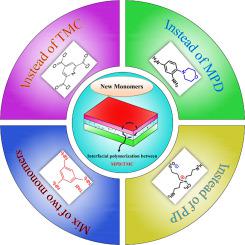Reactive & Functional Polymers ( IF 5.1 ) Pub Date : 2021-08-21 , DOI: 10.1016/j.reactfunctpolym.2021.105015 Javad Farahbakhsh 1 , Vahid Vatanpour 2 , Mahsa Khoshnam 3 , Masoumeh Zargar 1

|
Thin film composite (TFC) membranes have been experiencing significant modifications recently aiming to improve their structure, properties and separation efficiency. One of the promising modifications to tailor the membranes more efficient is changing the materials used. m-phenylene diamine (MPD), piperazine (PIP), and trimesoyl chloride (TMC) are the most common monomers used to fabricate TFC membranes. Recent studies have introduced several alternatives to these traditional monomers showing significant contribution of these monomers to the physicochemical properties of the membranes (e.g., surface roughness, hydrophilicity, cross-linking density, chemical structure) as well as membranes' separation efficiency. Emergence of more favorable functional groups such as carboxylic and amine groups due to the new materials integration facilitates the polymerization process and is beneficial to the membrane properties. Here, a critical review on the new interfacial polymerization monomers applied for reverse osmosis (RO) and nanofiltration (NF) membranes fabrication is presented. The membrane molecular structure and fabrication mechanism are investigated in details. This is followed by a review of the recent surface modification methods including grafting, coating and additive incorporating into the thin layer of membranes. The application of alternative monomers to MPD, PIP and TMC are investigated and the benefits of using these monomers or co-monomers are discussed.
中文翻译:

新单体和膜改性技术在薄膜复合膜制造中的应用最新进展:综述
薄膜复合 (TFC) 膜最近经历了重大改进,旨在改善其结构、性能和分离效率。更有效地定制膜的有希望的修改之一是改变所使用的材料。米-苯二胺 (MPD)、哌嗪 (PIP) 和均苯三甲酰氯 (TMC) 是用于制造 TFC 膜的最常见单体。最近的研究介绍了这些传统单体的几种替代品,表明这些单体对膜的物理化学性质(例如,表面粗糙度、亲水性、交联密度、化学结构)以及膜的分离效率有显着贡献。由于新材料的集成,更有利的官能团如羧基和胺基的出现促进了聚合过程,有利于膜的性能。在这里,对应用于反渗透 (RO) 和纳滤 (NF) 膜制造的新型界面聚合单体进行了批判性审查。详细研究了膜分子结构和制备机理。接下来是对最近的表面改性方法的回顾,包括接枝、涂层和添加到薄膜薄层中的添加剂。研究了替代单体在 MPD、PIP 和 TMC 中的应用,并讨论了使用这些单体或共聚单体的好处。



























 京公网安备 11010802027423号
京公网安备 11010802027423号